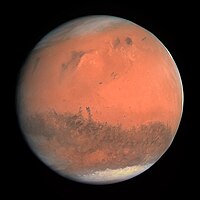
Photo from wikipedia
Previous work has demonstrated orbital stability for 100 Myr of initially near-circular and coplanar small bodies in a region termed the 'Earth-Mars belt' from 1.08 au $< a Click to show full abstract
Previous work has demonstrated orbital stability for 100 Myr of initially near-circular and coplanar small bodies in a region termed the 'Earth-Mars belt' from 1.08 au $< a <$ 1.28 au. Via numerical integration of 3000 particles, we studied orbits from 1.04-1.30 au for the age of the Solar system. We show that on this time scale, except for a few locations where mean-motion resonances with Earth affect stability, only a narrower `Earth-Mars belt' covering $a\sim(1.09, 1.17)$ au, $e<0.04$, and $I<1^\circ$ has over half of the initial orbits survive for 4.5 Gyr. In addition to mean-motion resonances, we are able to see how the $\nu_3$, $\nu_4$, and $\nu_6$ secular resonances contribute to long-term instability in the outer (1.17-1.30 au) region on Gyr time scales. We show that all of the (rather small) near-Earth objects (NEOs) in or close to the Earth-Mars belt appear to be consistent with recently arrived transient objects by comparing to a NEO steady-state model. Given the $<200$ m scale of these NEOs, we estimated the Yarkovsky drift rates in semimajor axis, and use these to estimate that primordial asteroids with a diameter of 100 km or larger in the Earth-Mars belt would likely survive. We conclude that only a few 100-km sized asteroids could have been present in the belt's region at the end of the terrestrial planet formation.
Journal Title: Monthly Notices of the Royal Astronomical Society
Year Published: 2020
Link to full text (if available)
Share on Social Media: Sign Up to like & get
recommendations!